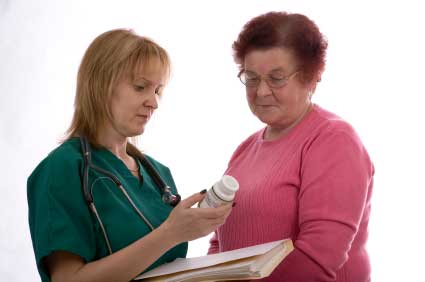Health Education: Gender Specific Preventive Health for Males and Females
Article Overview
Prostate exams are a critical component of preventive reproductive health for men. Although it can seem a bit invasive, early detection and treatment may allow for the reversal of symptoms or the eradication of cancer. Below is a description of a standard prostate exam, along with the various conditions your doctor is checking for.
Prostate Exam. While the prostate examination is usually not regularly performed on men until they reach their 50s, it is important to be aware of the procedure and the indicators for prostate cancer, the leading causes of cancer deaths in men. As you grow older, it will be critically important to your health to understand the signs and symptoms of prostate problems, as well as any preventative measures that you can take.
Also called a "digital rectal exam" the prostate exam is performed by the doctor (while wearing lubricated gloves) sticking a finger into the patient's anus to feel the shape and size of the prostate gland. The prostate is a small walnut sized gland located in front of the rectum and between the bladder and penis. The prostate manufactures fluid to protect the sperm, which is part of what makes up semen. When inserting a finger to examine the prostate, the doctor is looking to feel whether it is enlarged, sensitive to touch, or has any abnormal lumps or formations that may indicate a problem.
For most men, the prostate will be perfectly normal. However, if the prostate is swollen or tender, you may be suffering from Prostatitis, inflammation or infection of the prostate gland. This is normally treated with antibiotics and does not present a serious risk. However, if your doctor suspects cancer of the prostate, additional testing will be ordered to provide a positive diagnosis.
The main test that physicians use when diagnosing prostate cancer is the PSA test (Prostate Specific Antigen). This test identifies elevated levels of PSA in the blood which may be an indication of cancer activity. However, it is important to note that an elevated PSA level can also occur with non-cancerous swelling of the prostate called benign prostatic hyperplasia (BPH), which may occur due to a bacterial infection or as a common part of aging. If the swelling becomes too large or the patient has problems urinating, hormone therapy or surgery may be used to provide relief.
Were you previously aware of the prostate and its role in men's reproductive health?
Does anyone in your family have prostate issues?
Preventing Prostate Cancer
There are some dietary and lifestyle habits that can be adopted now, which may help to protect you from a diagnosis of prostate cancer later in life. Some suggested preventative measures include:
- Choose to eat a low-fat diet, as there has been a link between high-fat consumption and prostate cancer.
- Reduce dairy consumption as studies have shown that men who drink three cups of milk a day are 2.5 times more likely to develop prostate cancer.
- Reduce fat and protein from animal sources, as studies have shown that men who consume more of their protein and fat from healthy plant sources are less likely to get prostate cancer.
- Eat fatty fish, which contain an abundance of Omega-3 fatty acid. This reduces inflammation in the body and helps to protect against cancer.
- Reduce or eliminate alcohol from your diet, as it aids in cancer growth.
- Maintain an exercise regimen and strive for a healthy weight, as obesity has been shown to increase the risk of prostate cancer.
Examining the penis and testicles as part of the physical may occur earlier in life than a prostate exam. Some physicians will only check this area if you complain of problems, while others make it a mandatory part of routine physical examinations.
Testicular Cancer Screening
If you complain of pain, swelling, or there are abnormalities in the size and shape of the testicles, the doctor will perform an exam of the area. Often, the testicles are irritated due to injury or tight clothing. However there is also the possibility of a more serious condition, such as testicular cancer or a scrotal hernia (when part of the bowl has descended into the scrotum), which usually requires surgery.
- Significant loss of size in one of the testicles.
- Feeling of heaviness in the scrotum.
- Dull ache in the lower abdomen or in the groin.
- Sudden collection of fluid in the scrotum.
- Pain or discomfort in a testicle or in the scrotum.
Nearly all tumors found in the testicles are cancerous, so treatment is necessary in the case of a positive diagnosis. Treatments include radiation and chemotherapy, removal of the testicle, and depending on whether the cancer has spread, removal of lymph nodes, and removal of the entire prostate. However, it is important to note that testicular cancer treatment is very effective, with more than 95% of individuals surviving more than five years.
The physician may also examine the penis during a routine physical. The doctor will be checking for any abnormal bumps, lesions, warts, or ulcers that may be indicative of a sexually transmitted disease or a bacterial or fungal infection, such as jock itch.
If there is an indication of a possible problem on the penis, the physician may take a biopsy (a small piece of skin to examine under a microscope) or order blood work to confirm. Depending on the results, creams or antibiotics or other medications may be prescribed. In addition to the treatment prescribed by your doctor, you should be sure to keep the area clean and wash your hands frequently, so as not to spread any bacteria. Also, you should not engage in sexual intercourse until you know the nature of the problem and until it has been thoroughly treated.
Are you comfortable speaking to your doctor about sexual and reproductive health?
Is there another adult that you feel more comfortable directing your reproductive health questions to? How might you reach out to them?
Section 3. Self Examinations
As a physical only occurs once a year at most, it is important to know how to examine yourself and identify any unusual pains, swelling, or changes in appearance of your reproductive organs. Becoming familiar with your body allows you to quickly identify changes and quickly seek medical attention, which can be potentially lifesaving. Below are easy steps for self examination from the American Cancer Society, which should be done at least once a month once a boy reaches puberty.
How to do testicular self-exam
"The best time to do the self-exam is during or after a bath or shower, when the skin of the scrotum is relaxed. To do a testicular self-exam:
- Hold your penis out of the way and check one testicle at a time.
- Hold the testicle between your thumbs and fingers of both hands and roll it gently between your fingers.
- Look and feel for any hard lumps or smooth rounded bumps or any change in the size, shape, or consistency of the testes.
You should know that each normal testis has an epididymis, which feels like a small 'bump' on the upper or middle outer side of the testis. Normal testicles also contain blood vessels, supporting tissues, and tubes that conduct sperm. Other non-cancerous problems, such as hydroceles and varicoceles, can sometimes cause swellings or lumps around a testicle. It's easy to confuse these with cancer. If you have any doubts, see a doctor.
If you choose to check your testicles, you will learn what is normal for you and be able to tell when something is different. Always report any changes to a doctor right away."
How to do a penis self exam
When examining the penis, start at the tip and examine the top and underside of the shaft, including the foreskin. Look for any sores, skin lesions, bumps, or raw red patches or warts. When you arrive at the base of the penis, spread the hair in sections and feel for any abnormalities. Using a mirror can help in viewing hard to see areas and identifying strange feeling skin or sores.
Open sores, warts, and other changes to the penis may be the result of an infection or a sexually transmitted disease (STD). Any suspicious changes should be reported to your doctor for diagnosis and treatment.
Check In: Section 3.
- Do you regularly perform self examinations?
- Have you ever been worried about something that you discovered in a self exam?
Objectives
The female reproductive system is a complex group of internal and external parts that work together in managing overall feminine health. There are five specific parts that are most prominent and which require preventative maintenance and checkups to ensure optimal function over the course of your life. They are the:
Vagina. A stretchy tube which stretches from the visible external feminine sex organs (vulva) up into the body to the entrance of the womb (cervix). The vagina's role consists of being a recipient of sexual activity and as a canal which the baby travels through in childbirth.
Cervix. Called the "neck of the womb," the cervix is the narrow, lower portion of the uterus (womb), which opens up into the vagina. The cervix remains mostly closed throughout life and during pregnancy, unless the delivery of a baby is imminent. However, the cervix has small openings that allow the release of menstrual fluid and the entrance of sperm.
Uterus. The uterus or womb, as it is also known is a small pear shaped muscular sack that sits low in the pelvic cavity. The cervix is attached to the bottom of the uterus, which empties into the vagina. During ovulation a uterus secretes hormones that cause its lining to thicken in anticipation of an egg implanting and a subsequent pregnancy. However, in the event that a pregnancy does not occur, the lining is shed and expelled during the menstrual period. If an egg is implanted successfully, the uterus will move up out of the pelvis and enlarge to accommodate the growing baby.
Ovaries. These are a pair of small sacs, about the size of almonds which houses millions of eggs that have been nestled in the female body from birth. During the female reproductive cycle, the ovaries release one egg that travels towards the uterus in the hope of pairing with a sperm cell and implanting itself in the uterus to produce a baby. The ovaries also produce hormones such as estrogen and progesterone which have an impact on numerous body systems and processes.
Were you previously aware of all of the components of the female reproductive system?
If you are a female, do you feel differently during different times of the month leading up to your period?
Have you ever felt pain or discomfort in any of the areas listed above?
If you are sexually active, either your family doctor or OBGYN will most likely discuss birth control with you during your visit. The doctor will likely explain that while birth control does provide some protection against unintended pregnancy, it is not foolproof. Abstinence is the only completely foolproof means of pregnancy prevention and protection against sexually transmitted diseases.
Section 4. Vaginal and Cervical Health
Pap Tests
One of the main components of a visit to your gynecologist is the Pap test, also called a Pap smear. This test is an examination of the cells of the cervix to check for any abnormalities that can indicate infection, disease, or possible cervical cancer.
It is recommended that every female over the age of twenty one receive a Pap test at least every three years. This provides the best insurance of identifying problems early, which is treated promptly, can be cured. There is a high success rate of curing cervical cancer if it is detected in the early stages. It is important to note that the pap smear checks only for changes in the cervical cells that may lead to cervical cancer. Concerns about ovarian cancer or most common sexually transmitted diseases are addressed through additional testing.
In most cases of cervical cancer, the cause is the Human Papillomavirus, also known as HPV. This is a sexually transmitted virus that can cause changes in the cells of the cervix that can lead to cancer. There is now a vaccine that can be administered to guard against contracting HPV. Your doctor may discuss the vaccine as a preventative measure against cervical cancer.
What Happens in a Pap Test?
In a pap test, the gynecologist will collect cells from the cervix to be placed on a slide and examined under a microscope for abnormalities. This is done by using an instrument called a speculum to widen the vaginal opening, providing a clear view of the inside of the vagina and the cervix. A plastic spatula or brush is then used to remove some of the cervical cells, which are then placed in a solution and sent to the laboratory for examination.
Have you been to a Gynecologist yet for a routine examination? How did you feel about the experience?
Are currently taking or have you considered taking birth control? If so, have you seen any bodily or emotional changes?
Section 5. Breast Cancer Screening
Another staple of a female examination is the breast examination. With the rise in breast cancer rates, more doctors are focused on breast examinations for early detection. During an exam, the doctor will feel the breast tissue for any unusual lumps or changes in the breast tissue. The doctor will also ask about any changes in the way your breasts feel, as well as any discomfort of strange discharge unrelated to breastfeeding.
Clinical Breast Examinations (CBE) are usually recommended at least once every three years in your twenties and thirties. When you move into your forties and beyond, women are encouraged to have a breast examination yearly and if considered high risk, also to receive a mammogram. If a lump is found, a biopsy will usually be performed to positively diagnose if cancer or benign.
Beast Self Examinations are a way for you to become familiar with your breast and easily identify if anything changes between examinations. Some women perform self exams on a monthly basis, while others do a quick check every time they shower. To perform a self examination, raise one arm at a time and slowly explore one breast at a time, taking note of anything that feels strange, such as a ridge, lump, or puckering of the skin. If you do discover something that feels strange, report it to your doctor immediately. She can perform a more detailed examination and either confirm or rule out a potential problem.
As mentioned, mammograms are highly recommended for women over forty, especially if there is a family history of breast cancer or other risk factors. During a mammogram a small amount of radiation is sent into the breast to provide an x-ray image of the inside of the breast. This allows the doctor to detect masses that may not be evident from an external exam. It is important to note that researchers have cited mammograms as a means to detect cancer early and potentially save lives; there is also the risk of false positives, false negatives, over diagnosis (identifying a non-threatening lump which prompts fear and intervention), and also radiation poisoning. With mammograms, as with any health treatment, it is important to weigh both the benefits and harms.
Section 6. Hormonal Imbalances
- Check In: Section 6.
Do you have a family history of breast cancer? If so, how was it detected?
Have you ever experienced unexplained weight gain or infrequent periods that could point to hormonal imbalances?































